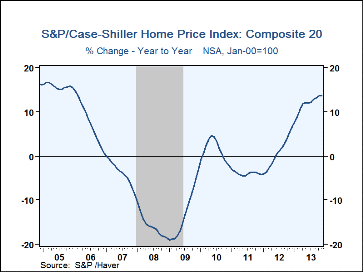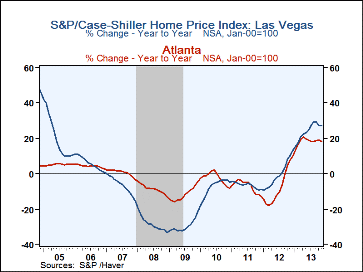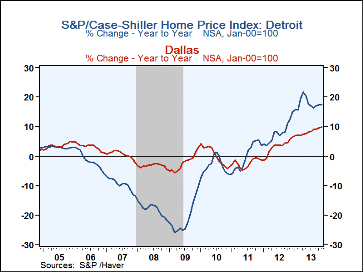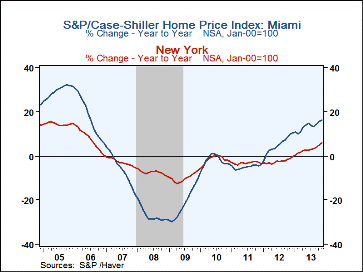 Global| Jan 28 2014
Global| Jan 28 2014U.S. Case-Shiller Home Price Index Shows Further Upward Momentum
by:Tom Moeller
|in:Economy in Brief
Summary
The seasonally adjusted Case-Shiller 20-City Home Price Index gained another 0.9% during November following increases near 1.0% during the prior three months. These lifted the y/y rise to 13.8%, its strongest since February 2006. The [...]
The seasonally adjusted Case-Shiller 20-City Home Price Index gained another 0.9% during November following increases near 1.0% during the prior three months. These lifted the y/y rise to 13.8%, its strongest since February 2006. The 3-month annualized rate of increase remained firm at 12.4% following its slowdown this spring. Home prices in the narrower 10-city group also gained 0.9% (13.9% y/y). Not adjusted for normal seasonal variation, the Case-Shiller 20-City Home Price Index slipped 0.1% in November after a 0.2% October gain.
Among individual cities, prices were strongest in Las Vegas where they rose 27.3% y/y, San Francisco which increased 23.3% y/y and Los Angeles which showed a 21.7 y/y rise. In each of these cities prices remained down roughly 20% or more from the 2006 peaks. Home prices have improved everywhere in the country but to a lesser extent. Gains were logged in New York, Cleveland and Washington D.C. with modest increases of roughly 6.0%. In these cities, prices remain down approximately 15% from their peaks.
The Case-Shiller home price series is value-weighted, i.e., a greater index weight is assigned to more expensive homes. It is a three-month moving average and is calculated using the "repeat sales method," where the item measured is the price change for a specific house compared to the price for that same house the last time it sold. The nation-wide S&P/Case-Shiller home price indexes can be found in Haver's USECON database, and the city data highlighted below are in the REGIONAL database.
| S&P Case-Shiller Home Price Index (SA, %) | Nov | Oct | Sept | Nov Y/Y |
2012 | 2011 | 2010 |
|---|---|---|---|---|---|---|---|
| 20 City Composite Index | 0.9 | 1.1 | 1.0 | 13.8 | 0.9 | -3.9 | 1.3 |
| Regional Indicators | |||||||
| Las Vegas | 1.2 | 1.0 | 1.4 | 27.3 | -0.3 | -6.5 | -7.7 |
| San Francisco | 1.3 | 0.7 | 1.4 | 23.3 | 3.5 | -4.9 | 9.3 |
| Los Angeles | 0.8 | 1.5 | 1.2 | 21.7 | 0.7 | -3.4 | 5.3 |
| San Diego | 0.7 | 0.6 | 1.2 | 18.7 | 1.2 | -4.4 | 7.3 |
| Atlanta | 1.6 | 1.9 | 2.0 | 18.6 | -7.8 | -7.0 | -2.4 |
| Detroit | 1.3 | 1.9 | 1.4 | 17.3 | 8.0 | 0.0 | -3.4 |
| Phoenix | 0.4 | 1.1 | 1.4 | 16.8 | 13.9 | -7.3 | -0.3 |
| Miami | 1.6 | 1.8 | 1.2 | 16.5 | 5.1 | -4.9 | -2.1 |
| Tampa | 1.1 | 0.9 | 1.0 | 15.8 | 2.7 | -6.6 | -4.0 |
| Portland | 0.7 | 0.5 | 0.9 | 12.6 | 1.7 | -7.1 | -3.2 |
| Seattle | 0.4 | 0.4 | 0.6 | 12.4 | 2.1 | -6.6 | -3.6 |
| Chicago | 0.8 | 0.8 | 0.7 | 11.1 | -2.8 | -6.8 | -3.7 |
| Minneapolis | 0.8 | 1.6 | 1.0 | 10.5 | 6.0 | -8.2 | 3.2 |
| Dallas | 1.0 | 1.0 | 0.9 | 10.0 | 3.2 | -2.4 | 0.1 |
| Boston | 1.3 | 0.9 | 1.2 | 9.8 | 0.5 | -2.0 | 1.9 |
| Denver | 0.5 | 0.3 | 0.8 | 8.9 | 4.5 | -2.1 | 0.9 |
| Charlotte | 0.5 | 1.2 | 0.5 | 8.7 | 1.7 | -3.6 | -3.4 |
| Washington, D.C. | 0.7 | 0.6 | 0.8 | 7.9 | 2.1 | -0.4 | 4.7 |
| Cleveland | 1.2 | 0.8 | 1.5 | 6.0 | 0.0 | -4.3 | 0.7 |
| New York | 0.8 | 0.8 | 0.6 | 5.0 | -2.3 | -3.1 | -1.5 |
Tom Moeller
AuthorMore in Author Profile »Prior to joining Haver Analytics in 2000, Mr. Moeller worked as the Economist at Chancellor Capital Management from 1985 to 1999. There, he developed comprehensive economic forecasts and interpreted economic data for equity and fixed income portfolio managers. Also at Chancellor, Mr. Moeller worked as an equity analyst and was responsible for researching and rating companies in the economically sensitive automobile and housing industries for investment in Chancellor’s equity portfolio. Prior to joining Chancellor, Mr. Moeller was an Economist at Citibank from 1979 to 1984. He also analyzed pricing behavior in the metals industry for the Council on Wage and Price Stability in Washington, D.C. In 1999, Mr. Moeller received the award for most accurate forecast from the Forecasters' Club of New York. From 1990 to 1992 he was President of the New York Association for Business Economists. Mr. Moeller earned an M.B.A. in Finance from Fordham University, where he graduated in 1987. He holds a Bachelor of Arts in Economics from George Washington University.










